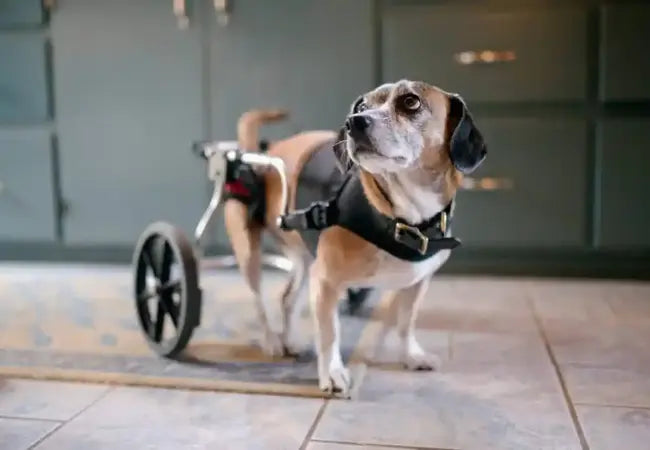Vet’s 2025 Guide to Canine Spinal & Vertebral Malformations Diagnosis, Treatment & Home Monitoring🩺

In this article
Vet’s 2025 Guide to Canine Spinal & Vertebral Malformations Diagnosis, Treatment & Home Monitoring🩺
By Dr. Duncan Houston BVSc
💡 What Are Vertebral Malformations?
Congenital vertebral malformations are abnormalities of the spine caused by improper development in utero. These include:
- 🟠 Hemivertebrae: half‑formed vertebrae leading to sharp curves—kyphosis, scoliosis, lordosis.
- 🟡 Butterfly vertebrae: sagittal cleft giving a butterfly appearance; usually incidental.
- 🟢 Transitional vertebrae: vertebrae with mixed features—often at cervicothoracic, thoracolumbar, or lumbosacral junctions.
- 🔵 Block vertebrae: fused vertebrae reducing flexibility and stressing adjacent discs.
- 🟣 Dens hypoplasia / atlantoaxial instability: underdeveloped C2 dens leading to cervical instability.
🚩 Who Is Affected?
- 🧬 Genetic predisposition: screw‑tailed breeds (French/English Bulldogs, Pugs, Boston Terriers), German Shepherds, Dobermans.
- 📏 Non‑brachycephalic breeds can also present atypical anomalies like block vertebrae.
- 🍼 Detected at birth or becomes apparent during growth spurts (4–10 months).
👀 Signs & Clinical Presentation
- 🦴 Visible spine distortions—curved back, hunched, or sway (lordosis, kyphosis, scoliosis).
- 🦵 Neurologic issues—hind limb weakness, paralysis, ataxia, crossing over limb placement.
- ⚠️ Incontinence when malformation impinges on nerves.
- 😖 Pain, reluctance to move, difficulty rising or climbing often in severe compression.
- 🐾 Some unaffected—many mild anomalies only discovered on X‑ray.
🧪 Diagnosis & Imaging
- Physical & neurological exam: assess gait, reflexes, pain.
- Plain radiographs (x‑rays): key for identifying hemivertebrae, block, transitional vertebrae, dens hypoplasia.
- CT scan: detailed bone evaluation for surgical planning.
- MRI: essential for meningocele/spinal cord involvement and soft tissue compression.
- Advanced tests: genetic screening not routine—investigation mainly via imaging and clinical signs.
🛠 Treatment Options
1. Conservative & Supportive Care 🏡
- 🧘♂️ Physical therapy: hydrotherapy, exercises, supports spinal strength and mobility.
- 🟰 Pain & anti‑inflammatory meds: NSAIDs, gabapentin, methocarbamol for pain and muscle spasms.
- 🦽 Mobility aids: harnesses, rugs, wheelchair for incontinent or weak dogs.
- 🏋️♀️ Weight management: essential to reduce spinal stress.
2. Surgical Intervention 🔧
- 🛠 Spinal decompression & stabilization: for severe compression from hemivertebrae/block vertebrae—improves neurologic signs.
- 🏥 Atlantoaxial stabilization: for dens hypoplasia—fixation of C1–C2 prevents spinal cord injury.
- 💉 Emerging techniques: stem‑cell therapy shows potential in select severe cases.
3. Prognosis & Long‑Term Outlook
- 🟢 Mild anomalies: Many dogs live symptom-free with conservative management.
- 🟡 Severe compression: early surgical decompression can stabilize and improve; prognosis varies.
- 🔴 Atlantoaxial instability: surgery significantly improves survival—without it, severe neurological deterioration is likely.
- ⚠️ Avoid breeding affected dogs due to hereditary causes.
🏡 Ask A Vet App Home Monitoring Tools 📲🐶
- 📆 Therapy & medication reminders to keep treatment on track.
- 📊 Log mobility: gait, incoordination, rising ability.
- 📸 Upload videos: detect subtle progression or pain signs.
- 🔔 Alerts: for sudden gait changes, incontinence, limb weakness.
- 📚 In-app guides: wheelchair fitting, rehab exercises, care routines.
🔑 Key Takeaways 🧠✅
- Vertebral malformations are common congenital conditions—many asymptomatic, some serious.
- Diagnosis relies on imaging—X‑rays, CT, MRI—plus neurological assessment.
- Treatments range from medical and rehab to complex surgery and stabilization.
- Prognosis varies widely—from normal life to needing lifelong care.
- Ask A Vet app enhances monitoring, enhances vet-owner collaboration to catch issues early.
🩺 Final Thoughts ❤️
In 2025, caring for dogs with vertebral malformations means blending expert neurologic care with compassionate, consistent home support. Advanced imaging and surgical options are available for many cases, and strong rehab protocols help maintain mobility. With Ask A Vet, owners aren’t alone—they’re empowered with tools to track progress, share info with vets remotely, and ensure their dog receives the best care possible. Whether your pup has a mild hemivertebra or needs stabilization surgery, digital support can make all the difference. 🐾✨
Visit AskAVet.com and download the Ask A Vet app to log treatments, upload videos, set alerts, track rehabilitation, and work closely with veterinary specialists for your dog’s spine health. 📲🐶






